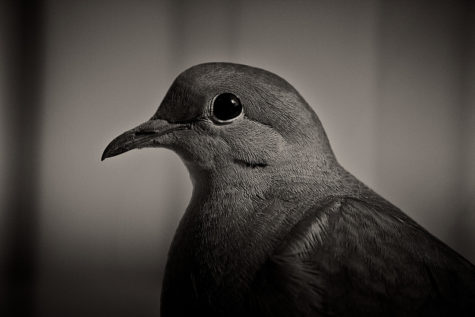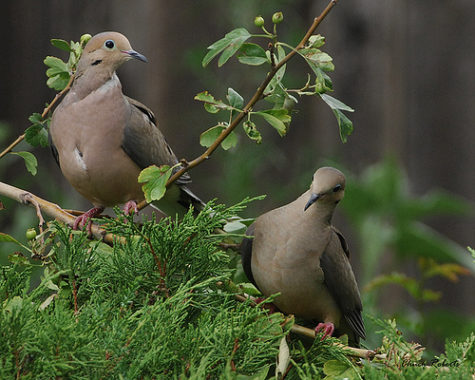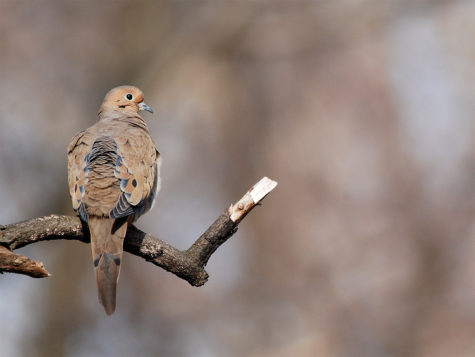
There’s great dignity in the mourning dove. Rarely does one demand attention. A pair’s gentle cooing is a pleasure, the whisper of parents trying not to wake the baby. The whir of their wings in flight (called sonation) recalls a wind-up toy. A couple of them, in velvety gray-brown with daubs of black low on the wings, has kept me company this summer—maybe the same pair that nested here last year. It’s been a warm season, which could support up to six two-chick clutches if a pair goes whole hog on reproduction. (The species is that prolific because mortality is high. I’ll come back to that point shortly.)
They’ve been so easy to get along with, these two, like neighbors you’d invite to come sip iced drinks through the hot afternoon. Though I startle them regularly—each time I open my back door into their territory—they hold no grudges. They may hop up a few branches or fly to the roof or a more distant tree, wings whistling, but in three shakes or so they’re back home.
Two curious facts about mourning doves: If threatened while incubating eggs, one parent might perform a broken-wing display—pretending to be injured on the ground—to distract a predator away from the nest. And both sexes produce food (called crop milk) for their young. Such dedicated parents they are. Too, as reputed, they are dedicated mates. In my yard, one’s up, one’s down, one’s here, one’s there, but always it’s the two of them, always close together.
And then, Geddy. The dog. You may remember Geddy from such posts as “My Dog Would Definitely Eat My Corpse” (LWON, July 2017). Early yesterday morning Geddy was poking around in the bushes, muscles taught and ears perked over something he’d discovered. I saw leaves rustle in front of his vibrating nose and so I went for him, fearing another injured bunny or a rat bite to his face (the latter, perhaps, he deserves). But he was quick and determined: He slid by me, a gray softball in his mouth.
It was Mrs. Mourning Dove. I’m fairly confident with my ID; male doves are more colorful–as is often true in birds—with subtle pinkish-purple patches at the neck and/or rosy chests, neither of which I recall seeing on the captured bird. I grabbed the dog’s collar and made him drop his prize, but it was too late. Her neck was bent wrong and a strand of gut hung from her belly. I picked her up and feathers scattered like fall leaves. Geddy chased me, jumping against my legs as I cradled the drooping bird above my head and moved toward the gate. I’d failed to save her life but I wouldn’t let this predator from my own household tear her to bits. She would go back to the soil in a soft, shady spot hidden from slobbery jaws.
Over our front fence is a narrow stretch of yard along our neighbor’s house, a mess of bushes and leggy weeds and suffocating vines that my neighbor has ignored for years. There, I thought, the dove’s broken body would not be disturbed.
I felt terrible, of course. My dog’s wild habits, while natural for his breed, go against my instinct to protect small helpless things. But I was unprepared for the powerful wave of sorrow I felt later that day. That was when I heard, and then saw, the dove’s mate. He was in a dying pine tree on a branch barely fit for a finch’s weight. He flitted up higher, then lower, seeking a stronger perch as each bent beneath him. But he stayed in that tree for a while, calling that plaintive dove call, watching me watch him. It was the tree just above that weedy stretch of yard where I’d laid the female to rest.
I admit it: I choked up at the sound and sight of him. Had he seen the attack or, afterwards, spotted her lying still in those bushes? Did that mean anything to him? Or was he simply looking for her now, unsure why she was, uncharacteristically, out of sight? They say doves mate for life. Are there exceptions to this sweet but potentially heartbreaking (at least for me) rule?
I needed ease, and closure. So I started reading. I learned that mourning doves in the wild are short lived; some sources put the average life span at less than two years. Mortality as a youngster is as high as 70 percent and 58 percent of adults die each year. Parasites and diseases kill a few, but most doves that survive long enough to fly die by a human’s gun or a wild predator’s tooth or claw. (Doves are speedy fliers—they’ve been clocked making a beeline at 55 mph—but they’re a bit sluggish on the uptake. At least that whir of wings may startle a foe, offering a moment’s head start.)
I took slight comfort in the fact that, statistically, had Geddy not caught that grounded bird a hawk would have swooped down and nabbed her sometime soon. But more reassuring was this: Although mourning doves are indeed loyal mates, if one dies the other will seek a new partner and get back to the business of making more doves.
As I write this I hear the surviving bird cooing in a big tree, one with solid perches, behind my house. Like him, I am listening, hopefully, for a reply.
UPDATE: Three days have passed since the unfortunate predation event. On days 1 and 2 the male bird was alone and calling, but today I saw him in conversation with a new female. While I’m relieved at his progress, and wondering what dating app he uses, I have to say it: Three days? Come on, Mister. That’s pretty quick to move on after the tragic death of your “forever” mate! Sigh. Birds these days…no respect for the bonds of marriage.
Top photo: Ryan Vaarsi via VisualHunt.com / CC BY
Middle photo:colorob via Visual hunt / CC BY-NC-ND
Billtacular via VisualHunt / CC BY-NC-ND
We have had mourning doves nesting around our house for years. One thing that we’ve noticed which is particular to the doves, is that they seem to be rather stupid compared to the other birds. Unlike the sparrows, mockingbirds, and hummers, whose nests are nearly impossible to find, the doves often build their nests in plain view of the crows stationed in the tops of almost all the nearby trees. Invariably one of two things occurs: the crows swoop down and eat everything in the nest, or the nest is so poorly built that the eggs drop through it onto the ground. Every year.
Except this year, when two pairs successfully raised two chicks each. We were on tenterhooks, watching those babies grow. The partents, oddly, didn’t view us as a threat and allowed us to get within about 2 feet of the nests to watch progress. Maybe they figured that our proximity would keep the predators away (?). In any event, we breathed a big sigh of relief when the chicks finally fledged.
The mourning doves are beautiful birds. Not as annoying as mockingbirds can be, and not as aggressive as hummers, who will sometimes get right in our faces and scold us for living. The mourning doves just sit and make their soft cooing sounds, watching the wonderful world with those soft dark eyes.
Thanks for sharing this, Dr. D! They are indeed beautiful.